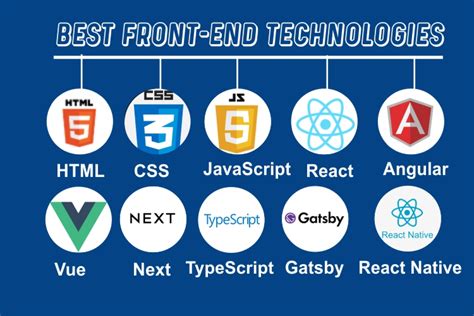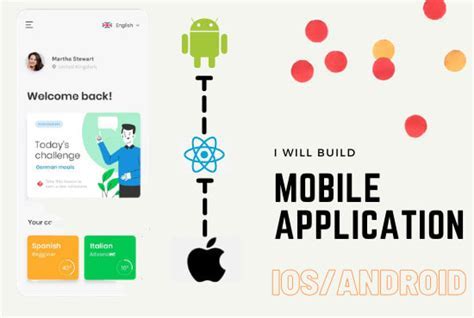In today's fast-paced digital landscape, smartphones have become an integral part of our lives, redefining the way we connect, communicate, and consume information. Behind every remarkable iOS mobile application lies a complex web of cutting-edge technologies that work seamlessly to deliver a user experience like no other. From powerful programming languages to robust frameworks, the world of iOS app development is a hub of innovation and creativity.
When it comes to crafting feature-rich iOS applications, developers leverage a multitude of tools and technologies to bring their ideas to life. These technologies act as the building blocks that empower developers to design intuitive interfaces, create seamless navigation, and deliver top-notch performance. By harnessing the potential of these technologies, developers can tap into the vast pool of possibilities and create applications that cater to the diverse needs and preferences of millions.
One of the fundamental aspects of iOS app development revolves around selecting the right programming language. Swift, an elegant, robust, and lightning-fast language, has emerged as the go-to choice for developers looking to create powerful iOS applications. Thanks to its simplicity, efficiency, and interoperability, Swift enables developers to write code that is not only expressive but also highly maintainable. While Objective-C, a traditional and time-tested language, still holds its ground, Swift has gained immense popularity due to its modern approach and developer-friendly syntax.
Front-End Technologies for Building iOS Applications

In the world of developing iOS applications, front-end technologies play a crucial role in creating visually appealing and user-friendly interfaces. These technologies encompass a diverse set of frameworks, libraries, and tools that enable developers to design and implement the user interface of iOS mobile applications without getting into the nitty-gritty details of the underlying operating system.
At the heart of front-end development for iOS lies the Swift programming language, which is specifically designed by Apple for building robust and responsive applications. Swift provides developers with a powerful and intuitive syntax, making it easier to create interactive and dynamic user interfaces. Alongside Swift, developers can leverage the UIKit framework to build and customize user interface components, such as buttons, labels, and navigation bars, ensuring a seamless and consistent user experience across iOS devices.
In addition to Swift and UIKit, front-end developers can also utilize Auto Layout and Interface Builder to create adaptive and responsive layouts that adapt to different screen sizes and orientations. Auto Layout allows developers to define constraints and relationships between UI elements, ensuring their proper positioning and behavior, while Interface Builder provides a visual interface for designing and arranging the user interface components.
Furthermore, front-end developers can enhance the interactivity of iOS applications by leveraging frameworks like Core Animation and Core Graphics. Core Animation enables the creation of smooth and visually appealing animations, adding a touch of dynamism and engagement to the user interface. On the other hand, Core Graphics enables developers to draw custom graphics and images, enabling the creation of unique and eye-catching visual elements.
Finally, front-end technologies for iOS also encompass the incorporation of third-party libraries and frameworks that extend the capabilities of iOS applications. These libraries provide additional functionality and features, allowing developers to integrate things like data visualization, networking, and user authentication seamlessly into their applications.
In conclusion, front-end technologies for iOS mobile applications encompass a wide range of tools and frameworks that enable developers to create exceptional user interfaces and experiences. From the Swift programming language to UIKit, Auto Layout, and Core Animation, these technologies empower developers to design visually stunning, interactive, and adaptive interfaces that delight users on iOS devices.
Swift as the Primary Programming Language
Within the realm of developing applications for the iOS platform, a significant aspect lies in the choice of the programming language. As technology evolves, programming languages continue to advance as well, aiming to enhance development efficiency and provide optimal performance for mobile applications on iOS devices.
One of the key languages that have emerged in recent years as a go-to choice for iOS app development is Swift. Swift, a powerful and intuitive language, offers developers a seamless experience in creating highly functional, efficient, and responsive iOS applications.
With its concise syntax and modern approach, Swift streamlines the development process, allowing developers to write clean and readable code. Its strong type inference system reduces coding errors and enhances code maintainability, providing a solid foundation for building robust and bug-free iOS applications.
Moreover, Swift's vast ecosystem and extensive support from Apple enable developers to leverage a wide range of libraries, frameworks, and tools for rapid and efficient application development. From user interface design to complex data processing, Swift provides countless resources that cater to various aspects of iOS app development.
Additionally, Swift's compatibility with Objective-C, the language previously widely used for iOS development, allows developers to easily integrate existing Objective-C code into Swift projects, thereby streamlining the migration process and providing seamless compatibility with legacy codebases.
It is worth noting that Swift's continuous development and updates further contribute to its popularity as the primary programming language for iOS app development. Apple's commitment to improving Swift ensures that developers have access to the latest features, optimizations, and tools, making it an ideal choice for staying at the forefront of iOS app development.
All in all, with its modern syntax, solid performance, extensive support, and continuous advancements, Swift has firmly established itself as the primary programming language for creating innovative and high-quality iOS mobile applications.
Interface Builder: Streamlining User Interface Development

When it comes to creating user-friendly and visually appealing iOS mobile applications, the process of designing the user interface plays a crucial role. In this section, we will explore the significance of Interface Builder in simplifying and enhancing the user interface development process for iOS apps.
Interface Builder is a powerful tool that enables developers to design, modify, and preview the user interface of an iOS app without having to write code manually. By providing a visual interface, Interface Builder allows developers to easily manipulate various UI elements, such as buttons, labels, text fields, and images. This visual design approach not only saves time and effort but also facilitates collaboration between designers and developers.
One of the main advantages of using Interface Builder is its drag-and-drop functionality. Developers can easily add, arrange, and resize UI elements by simply dragging and dropping them onto the interface canvas. This intuitive process eliminates the need for manually coding each individual element, resulting in a more streamlined and efficient development workflow.
In addition to its drag-and-drop feature, Interface Builder offers a wide range of customization options for UI elements. Developers can easily tweak properties such as fonts, colors, sizes, and alignment, to achieve the desired look and feel of the app's user interface. This flexibility allows for quick iterations and enables developers to experiment with different design choices before settling on the final design.
Interface Builder also provides various layout tools that help developers create responsive and adaptive interfaces. With features like auto layout and constraints, developers can define the relationships and behaviors between UI elements, ensuring that the app's user interface adapts seamlessly to different screen sizes and orientations. This flexibility is especially essential in today's mobile landscape, where devices come in various shapes and sizes.
In conclusion, Interface Builder is an indispensable tool for iOS app development, empowering developers to create visually appealing and user-friendly interfaces without the need for extensive coding. Its drag-and-drop functionality, customization options, and layout tools streamline the user interface development process, making it an invaluable asset in the creation of iOS mobile applications.
Using SwiftUI to Develop Engaging and Responsive User Interfaces
SwiftUI, a cutting-edge technology designed specifically for building visually appealing and adaptable user interfaces, plays a significant role in modern iOS app development. With SwiftUI, developers can create elegant and immersive user experiences that seamlessly adapt to different devices and screen sizes.
By harnessing the power of declarative syntax, SwiftUI simplifies the process of designing and prototyping user interfaces. It provides an intuitive and efficient way to build UI components, making it easier for developers to focus on achieving their desired application functionality.
One of the key advantages of SwiftUI is its ability to create responsive user interfaces that automatically adapt to various screen sizes and orientations. With SwiftUI's layout system and adaptive UI elements, developers can easily develop apps that look beautiful on both iPhones and iPads, as well as take full advantage of features like Split View and Slide Over on iPadOS.
Additionally, SwiftUI offers a wide range of UI controls and views that enable developers to create visually stunning and interactive interfaces. From buttons and sliders to complex scroll views and animations, SwiftUI provides a comprehensive set of tools to bring app designs to life.
Furthermore, SwiftUI seamlessly integrates with various Apple frameworks and technologies, such as Combine for handling asynchronous events and data flow, Core Data for data persistence, and ARKit for developing augmented reality experiences. This integration allows developers to leverage the full potential of iOS ecosystem and create feature-rich applications.
In conclusion, SwiftUI empowers iOS developers with a powerful and efficient toolset for creating attractive and responsive user interfaces. Its declarative syntax, adaptive design capabilities, and seamless integration with other Apple frameworks make it a must-have technology for building engaging iOS applications.
Building the Back-End Foundation for iOS Mobile Apps

When it comes to developing powerful and efficient iOS mobile applications, it is essential to establish a robust back-end infrastructure. The back-end technologies employed form the backbone of the application, ensuring seamless data retrieval, storage, and overall functionality. This section explores the fundamental components that make up the back-end architecture, highlighting their crucial role in delivering a smooth user experience and enabling advanced functionality.
Data Management: One of the key aspects of back-end technologies is effective data management. This involves organizing, storing, and retrieving data from various sources, such as databases, web services, and external APIs. Developers utilize database management systems, object-relational mapping frameworks, and efficient query languages to ensure reliable data persistence and fast retrieval. By implementing optimized data management techniques, iOS mobile applications can deliver real-time information and facilitate seamless interactions.
Server-Side Programming: Another critical component of the back-end architecture is server-side programming. This involves writing code that runs on the server and handles client requests, processing data, and generating responses. Popular server-side programming languages, such as Ruby, Python, and Node.js, provide powerful frameworks and libraries that simplify development tasks. Leveraging server-side programming, developers create the logic and functionality behind the scenes, enabling iOS mobile apps to communicate with databases, external APIs, and other services.
API Development: Application Programming Interfaces (APIs) play a vital role in facilitating communication between the back-end and front-end components of iOS mobile applications. Developers employ technologies and frameworks like REST, GraphQL, or SOAP to design, develop, and expose APIs. By creating well-designed and secure APIs, iOS applications can seamlessly interact with external services, retrieve necessary data, and ensure consistent performance and functionality.
Cloud Services Integration: To enhance the scalability, reliability, and performance of iOS mobile applications, integration with cloud services is crucial. Developers utilize cloud platforms, such as Amazon Web Services (AWS), Google Cloud Platform (GCP), or Microsoft Azure, to host and deploy their back-end infrastructure. These platforms provide a wide range of services like storage, computing power, machine learning, and database solutions. Leveraging cloud services enables developers to handle increased traffic, store vast amounts of data, and scale their applications effectively.
Security and Authentication: Ensuring the security and integrity of the data exchanged within an iOS mobile application is of utmost importance. Back-end technologies offer various mechanisms for implementing authentication, authorization, and encryption. Developers utilize techniques like OAuth, JSON Web Tokens (JWT), and SSL/TLS protocols to ensure secure communication and protect sensitive user information. By implementing robust security measures, iOS applications can gain user trust and prevent unauthorized access to data.
In conclusion, the back-end technologies used in the development of iOS mobile applications form the foundation that supports efficient data management, server-side programming, API integration, cloud services, and security measures. By selecting and implementing the appropriate back-end technologies, developers can create powerful and reliable applications with seamless user experiences.
[MOVIES] [/MOVIES] [/MOVIES_ENABLED]FAQ
Which technologies are commonly used for creating iOS mobile applications?
There are several technologies commonly used for creating iOS mobile applications, such as Swift and Objective-C programming languages, Xcode IDE, Cocoa Touch framework, and various third-party libraries and frameworks.
What is Swift programming language and why is it often used for iOS app development?
Swift is a modern programming language developed by Apple specifically for iOS, macOS, watchOS, and tvOS app development. It is preferred by developers because of its simplicity and readability, which helps in writing clean and maintainable code. Swift also offers better performance compared to Objective-C and provides features like optionals, type safety, and automatic memory management.
What is Xcode IDE and why is it important for iOS development?
Xcode is an integrated development environment (IDE) provided by Apple for iOS, macOS, watchOS, and tvOS app development. It is used to write, test, and debug iOS applications. Xcode includes a range of tools and features such as Interface Builder, Simulator, and built-in code editor, which make it easier for developers to create and deploy iOS apps.
What is the role of Cocoa Touch framework in iOS app development?
Cocoa Touch is a framework provided by Apple for building iOS applications. It includes a set of APIs and components that enable developers to create user interfaces, handle touch events, access device hardware features, and perform other common tasks while developing iOS apps. Cocoa Touch provides ready-to-use classes and libraries that help streamline the app development process.
Are there any third-party libraries or frameworks commonly used in iOS app development?
Yes, there are several third-party libraries and frameworks commonly used in iOS app development. Some popular examples include Alamofire for network request handling, Realm for database management, Firebase for backend services, and SwiftUI for building user interfaces. These libraries and frameworks provide additional functionality and simplify the development process for iOS apps.
What are the technologies used for creating iOS mobile applications?
The technologies commonly used for creating iOS mobile applications include Swift, Objective-C, Xcode, and various iOS frameworks such as UIKit, Core Data, and Core animation.




